Bronze walls
Like the idea of catching 75 or more smallies in a day? Start fishing wing dams
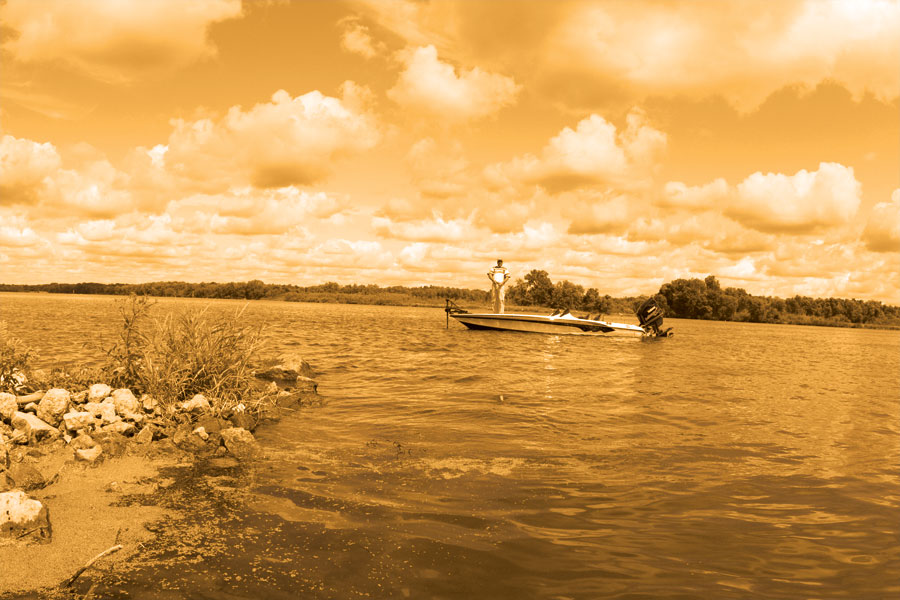
————————————–
Editor’s note: This is just one article from a recent issue of FLW Outdoors Magazine, which publishes both a Bass Edition and a Walleye Edition. To learn more about the magazine and how to subscribe, click here.
————————————–
Sunken beneath the expanse that is the Mississippi River, where a turbulent current wages war against chunks of granite, lies angling bliss for anyone venturing to the Midwest.
From both boat and shore, bliss often looks nothing like what one would imagine, just a section of flat-calm surface abutting a second section of ripples and gurgles. While the rest of the river’s surface continues downstream, these sections of yin and yang jut out from shore like scars. They don’t flow with the rest of the river. They stand perpendicular to it in defiance.
Defiance is a particularly choice word, for a look below the scars unveils sunken peninsulas, commonly known as wing dams, stretching toward the main channel. The stone-solid structures of rubble and debris were made solely to defy and are the very base for the slack water above them.
Walleye anglers know all about these walls of scrap, as they are prime locations to catch dinner. Throw a surface lure over the top, however, and bass anglers will get a different response: bliss, in the form of a flash of tarnished bronze and a stressed rod.
Pro Curtis Samo of Rochelle, Ill., has seen this euphoric response thousands of times, and it never gets old.
“I can’t get enough of that,” said Samo, a Mississippi River stick who has won two Walmart FLW Bass Fishing League Great Lakes Division events on the river. “It’s a riot. When it’s right I’ve caught more than 100 bass in a day, and I’m not talking shorts; 2- and 3-pounders along with some 4s. I had one day where I had three doubles on the same lure.”
If the idea of wearing out your rotator cuff on river-hardened smallmouths isn’t bliss then you need to take up another sport. Mississippi smallies hit like a Manny Pacquiao left hook and fight even harder. Chasing this kind of bliss, however, means brushing up on river terminology and venturing out into unchartered bass waters for most. Trust us, it’s worth it.
Wing dam 101
For anglers who didn’t grow up on the shores of the Mississippi or any other major river, wing dams are man-made barriers designed to reduce sedimentation in rivers and keep the main channel clear for 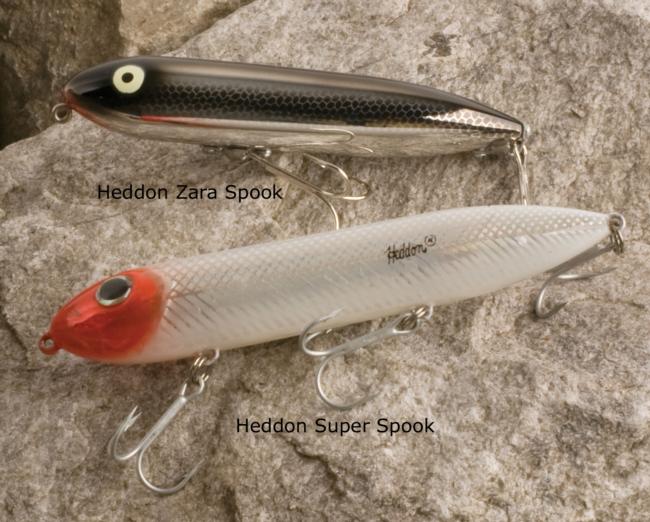 barges. Running perpendicular to shore and the natural flow of the river, these long piles of chunk granite, concrete rubble and gravel stretch from shore to the edge of the main channel.
barges. Running perpendicular to shore and the natural flow of the river, these long piles of chunk granite, concrete rubble and gravel stretch from shore to the edge of the main channel.
Some wing dams can be seen above the surface during periods of low water, but most are hidden beneath, where they divert the flow of current and trap any sediment and debris moving downstream.
This crashing of water against the wing dam forces water up and over the top of the structure, which is why the surface above a wing dam has what some refer to as a “boil line” of ripples. The water-with-structure contact also creates a circular motion of water on the face of the wing dam called an eddy. The water around the eddy crashes and spins, but the current inside is far less.
It’s in the slack-water eddy that bass rest and wait for food to come to them. Because of the unfathomable number of nooks and crevices on a wing dam’s face, they’re already host to numerous prey items like crayfish and minnows. The real treats, however, are the shad that get forced against the wing dam’s face, where they become easy meals for waiting bass.
Finding wings
The idea of finding a sunken mass of potentially boat-sinking rocks while fighting a river’s current is enough for some anglers to skip to the next article. It’s not as hard as it sounds, though.
In the Mississippi alone there are thousands of wing dams, all of which are mapped out for anglers. Most major wing dams are also marked with buoys. To find the unmarked ones, however, simply look at the surface of the river for those boil lines where slack-calm water meets ripples.
Of all the wing dams, not all are created equal. While they all have the same purpose, the unfaltering beating from the current and accumulation of debris make certain wing dams better than others. Unfortunately, trial and error is really the only way to establish which wing dams hold the most bliss.
However, there are a few things to help anglers get started. Wing dams tend to be built in rows, spaced evenly apart down stretches of a river, which makes it time consuming to check each and every one. Although wing dams in the middle of a row can be productive, river rookies should focus on the first and last wing dams in a row, which are usually the most productive.
When targeting smallies, wing dams within a mile of the main dam tend to be good starting points, as are wing dams near the mouths of creeks, especially around spawning time. Shallower wing dams, like in 2 to 5 feet of water, also have been Samo’s favorites, especially for the topwater bite.
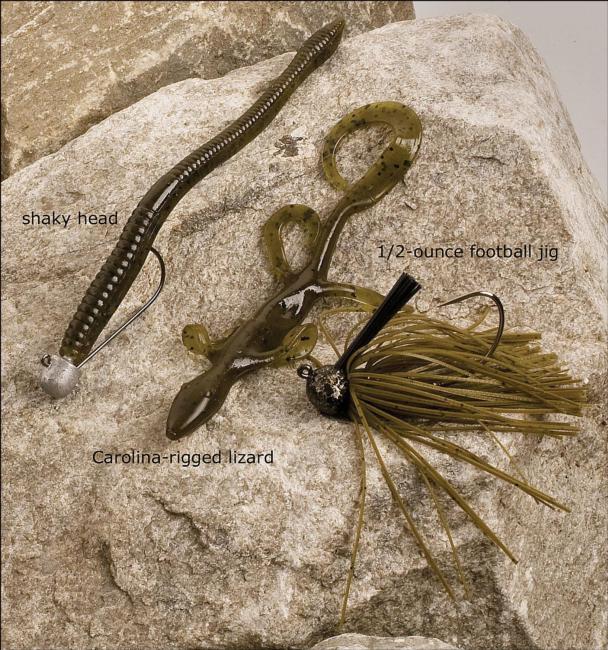 There are also areas to take note of on each individual wing dam.
There are also areas to take note of on each individual wing dam.
“Usually there is one little area that will be the sweet spot,” Samo said. “Maybe there’s a tree or a blow hole – a hole in the face of the dam – but something will be there that increases the flow and gets the fish more active.
“If you’re using subsurface lures you should be able to feel a difference in the pull of the current around these areas. You can also use your eyes to watch the current and look for stronger eddies or pushes. These sweet spots tend to be closer to shore.”
Scaling the wall
Before dreaming about catching 100 bronzebacks in a day, take a long look at the precautions necessary to approach and fish a wing dam (see sidebar). Once safety is accounted for, though, bliss is not far behind.
The wing dam bite goes on year-round. However, between July and October is when Samo stays locked to the dams. Low water levels are a must to pull bass from the creeks and group them on wing dams. However, low water doesn’t mean anglers want low current.
“I like to have some flow on them,” Samo said. “A little push gets the fish more active.”
The strength of the current will determine how bass set up on a wing dam. In a light to moderate current, bass sit in the eddy along the face of the wing dam. A heavier current will force them behind the wing dam to the downstream side, where they’ll wait to ambush prey forced over or around the dam.
Current strength can also play a role in determining which wing dams an angler targets. Light current should send anglers to the wing dams at the front of a row, farthest upstream. A heavy current, however, will push bass farther down the row, and anglers should follow by fishing the last wing dams in a given row.
Once in position on a wing dam, it’s time for the fun part: tossing topwaters. Positioned downstream of the dam, use the trolling motor to move the boat parallel to the structure, starting deep and working 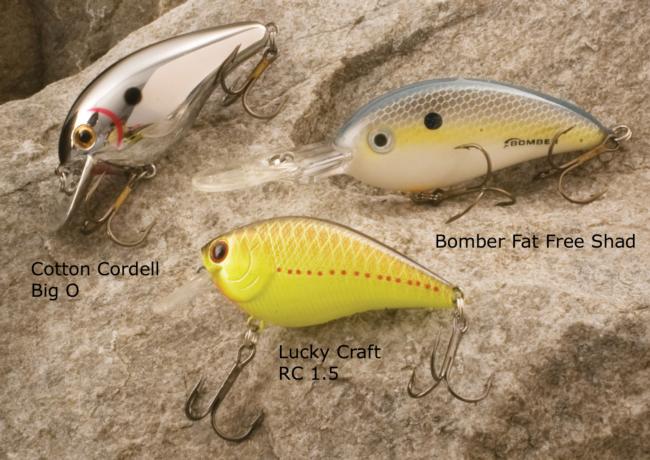 shallow. Meanwhile, make long casts over the wing dam, perpendicular to the wing dam itself, and work the lure back to the boat. Make sure the topwater travels through the area of calm water above the wing dam. That is where most strikes will occur.
shallow. Meanwhile, make long casts over the wing dam, perpendicular to the wing dam itself, and work the lure back to the boat. Make sure the topwater travels through the area of calm water above the wing dam. That is where most strikes will occur.
Samo’s go-to topwaters are walk-the-dog-style lures like the Heddon Zara Spook and Super Spook on 20-pound monofilament line, although numerous topwater lures will work. Morning is obviously the best time for the technique. However, don’t be afraid to keep chucking topwaters under the midday sun. The bites will be fewer, but the quality is worth the wait.
If the topwater bite dwindles, pick up a shaky head or a 1/2-ounce football jig and work it over the rocks, which is just as productive. The sharp structure does mean anglers will have to beef up their gear, though.
“The rocks and jagged edges will cut through line pretty easy,” Samo said. “Braid is a little more abrasion-resistant so I tend to spool up with 20- to 30-pound test. With that strong of line I can usually just pull on a snag and open a hook.”
Even with the stronger line check frequently for nicks and cuts, and retie often. Wing dam smallies hit hard enough that nicks can turn into break-offs in a devastating hurry.
Once the topwater bite dwindles after the sweltering months of July and August, the bite in September and October will still be blistering, just on different lures.
Fall brings a shad run on the Mississippi River, one smallies and largemouths use to fatten up prior to winter. This is prime crankbait time, and it’s when Samo really gives his shoulder sockets a workout.
“The shad will be coming down the river, and the bass go crazy,” Samo said. “I like banging big, lipped crankbaits off the rocks. My best days have all come during this time. I’ll have days when I catch bass on 14 casts in a row, make 10 more casts and then catch another 14 in a row.”
While topwaters and jigs can be worked perpendicular to a wing dam, it’s much harder with a crankbait. Samo instead opts for a parallel approach. The easiest way is by sitting his boat just off the end of the wing dam and making parallel casts with a Lucky Craft RC 1.5, Cotton Cordell Big O or Bomber Fat Free Shad, depending on the depth of the wing dam.
Before setting up on the end of a wing dam, be aware that some dams will have unmarked rock piles off the ends left over from when they were built. Some can come up very shallow and harm boats. However, they can also hold schools of bass.
Once safely in place, the main objective is to deflect off the structure without snagging every cast. Samo will also go with a Carolina-rigged lizard for deeper wing dams and a slower approach. Again, opt for at least 20-pound-test line to fight abrasion and handle the rigors of catching so many bass in a day.
Another option for parallel casting is to again stay on the down-current side of the wing dam, putting the nose of the boat close to the dam and then making parallel casts. This is a perfect option to hit entire wing dams during periods of strong current. A weaker current will have bass residing on the upstream 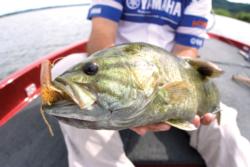 side of the wing dam, however, sometimes 10 to 15 feet in front of the dam. In such instances an angler will have to venture to the upstream side. The lesser current will make this a somewhat safer tactic, but continue to use extreme caution and monitor position in regard to the wing dam.
side of the wing dam, however, sometimes 10 to 15 feet in front of the dam. In such instances an angler will have to venture to the upstream side. The lesser current will make this a somewhat safer tactic, but continue to use extreme caution and monitor position in regard to the wing dam.
With the right precautions bliss is a simple thing to attain. It may not look like much prior to the first cast, but when your arms resemble Jell-O at day’s end and there’s a twinge in your cheeks from smiling too much, you’ll be floored at how magnificent an oil slick of calm water and a heap of rock can look.
Don’t wing it
Even the best “river rats” know caution should always be used around wing dams. Unlike a weedbed or point, wing dams are jagged, unmoving objects that can sometimes top off a foot or so below the surface. And they have no qualms about doing harm to a boat.
When approaching a wing dam, always begin idling well before reaching even the tip of the dam. The current and the lack of ability to see the structure can get anglers in trouble when trying to approach too quickly.
Also make sure to approach parallel to the wing dam on the downstream side. Once in position, use the trolling motor to point the boat upstream to have the most control against the current. The biggest thing is keeping the boat downstream of the structure so if the boat gets too close it can simply drift away from the dam in the current.
Fishing the upstream side can be done by more experienced river anglers by using the trolling motor to hold in position against the current. However, no matter the experience level, it’s still a dangerous idea. One mistake in position or wrong turn of the trolling motor can let the current slam the boat against the wing dam. If one is going to wander onto the upstream side, do so during times of low current as it lessens the risks.